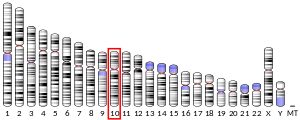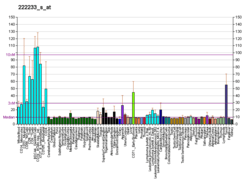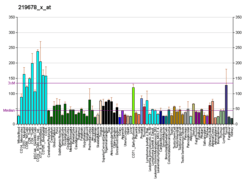Artemis (protein)
Artemis is a protein that in humans is encoded by the DCLRE1C (DNA cross-link repair 1C) gene.[5][6]
Function
Artemis is a nuclear protein that is involved in V(D)J recombination and DNA repair. The protein has endonuclease activity on 5' and 3' overhangs and hairpins when complexed with PRKDC.[7]
Immune response
Artemis plays an essential role in V(D)J recombination, the process by which B cell antibody genes and T cell receptor genes are assembled from individual V (variable), D (diversity), and J (joining) segments.[8] For example, in joining a V segment to a D segment, the RAG (recombination activating gene) nuclease cuts both DNA strands adjacent to a V segment and adjacent to a D segment. The intervening DNA between the V and D segments is ligated to form a circular DNA molecule that is lost from the chromosome. At each of the two remaining ends, called the coding ends, the two strands of DNA are joined to form a hairpin structure. Artemis nuclease, in a complex with the DNA-dependent protein kinase (DNA‑PK), binds to these DNA ends and makes a single cut near the tip of the hairpin. The exposed 3' termini are subject to deletion and addition of nucleotides by a variety of exonucleases and DNA polymerases, before the V and D segments are ligated to restore the integrity of the chromosome. The exact site of cleavage of the hairpin by Artemis is variable, and this variability, combined with random nucleotide deletion and addition, confers extreme diversity upon the resulting antibody and T-cell receptor genes, thus allowing the immune system to mount an immune response to virtually any foreign antigen.[9] In Artemis-deficient individuals, V(D)J recombination is blocked because the hairpin ends cannot be opened, and so no mature B or T cells are produced, a condition known as severe combined immune deficiency (SCID). Artemis was first identified as the gene defective in a subset of SCID patients that were unusually sensitive to radiation.
Repair of DNA breaks
Cells deficient in Artemis are more sensitive than normal cells to X‑rays[5] and to chemical agents that induce double-strand breaks (DSBs),[10] and they show a higher incidence of chromosome breaks following irradiation.[11] Direct measurement of DSBs by pulsed-field electrophoresis indicates that in Artemis-deficient cells 75-90% of DSBs are repaired rapidly, just as in normal cells. However, the remaining 10-20% of DSBs that are repaired more slowly (2-24 hr) in normal cells, are not repaired at all in Artemis-deficient cells.[12] Repair of these presumably difficult-to-rejoin breaks also requires several other proteins, including the Mre11/Rad50/NBS1 complex, the ataxia telangiectasia mutated ATM kinase, and 53BP1. Because Artemis can remove damaged ends from DNA,[10] it has been proposed that these DSBs are those whose damaged ends require trimming by Artemis. However, evidence that both ATM and Artemis are specifically required for repair of DSBs in heterochromatin,[13][14] has called this interpretation into question.
Artemis functions in the repair of DNA double-strand breaks that arise by induced oxidative reactions, or by endogenous reactions.[15] Such DNA repair occurs in heterochromatin as well as in euchromatin.
Clinical significance
Mutations in this gene cause Athabascan-type severe combined immunodeficiency (SCIDA).[16]
Interactions
DCLRE1C has been shown to interact with DNA-PKcs.[17]
References
- GRCh38: Ensembl release 89: ENSG00000152457 - Ensembl, May 2017
- GRCm38: Ensembl release 89: ENSMUSG00000026648 - Ensembl, May 2017
- "Human PubMed Reference:". National Center for Biotechnology Information, U.S. National Library of Medicine.
- "Mouse PubMed Reference:". National Center for Biotechnology Information, U.S. National Library of Medicine.
- Moshous D, Callebaut I, de Chasseval R, Corneo B, Cavazzana-Calvo M, Le Deist F, Tezcan I, Sanal O, Bertrand Y, Philippe N, Fischer A, de Villartay JP (May 2001). "Artemis, a novel DNA double-strand break repair/V(D)J recombination protein, is mutated in human severe combined immune deficiency". Cell. 105 (2): 177–86. doi:10.1016/S0092-8674(01)00309-9. PMID 11336668.
- Li L, Drayna D, Hu D, Hayward A, Gahagan S, Pabst H, Cowan MJ (Mar 1998). "The gene for severe combined immunodeficiency disease in Athabascan-speaking Native Americans is located on chromosome 10p". Am. J. Hum. Genet. 62 (1): 136–44. doi:10.1086/301688. PMC 1376812. PMID 9443881.
- "Protein Knowledgebase: Gene DCLRE1C - DNA cross-link repair 1C protein (Protein artemis)". Retrieved June 2, 2011.
- de Villartay JP (2009). "V(D)J recombination deficiencies". Adv. Exp. Med. Biol. Advances in Experimental Medicine and Biology. 650: 46–58. doi:10.1007/978-1-4419-0296-2_4. ISBN 978-1-4419-0295-5. PMID 19731800.
- Lu H, Schwarz K, Lieber MR (2007). "Extent to which hairpin opening by the Artemis:DNA-PKcs complex can contribute to junctional diversity in V(D)J recombination". Nucleic Acids Res. 35 (20): 6917–23. doi:10.1093/nar/gkm823. PMC 2175297. PMID 17932067.
- Povirk LF, Zhou T, Zhou R, Cowan MJ, Yannone SM (February 2007). "Processing of 3'-phosphoglycolate-terminated DNA double strand breaks by Artemis nuclease". J. Biol. Chem. 282 (6): 3547–58. doi:10.1074/jbc.M607745200. PMID 17121861.
- Deckbar D, Birraux J, Krempler A, Tchouandong L, Beucher A, Walker S, Stiff T, Jeggo P, Löbrich M (March 2007). "Chromosome breakage after G2 checkpoint release" (PDF). J. Cell Biol. 176 (6): 749–55. doi:10.1083/jcb.200612047. PMC 2064048. PMID 17353355.
- Riballo E, Kühne M, Rief N, Doherty A, Smith GC, Recio MJ, Reis C, Dahm K, Fricke A, Krempler A, Parker AR, Jackson SP, Gennery A, Jeggo PA, Löbrich M (December 2004). "A pathway of double-strand break rejoining dependent upon ATM, Artemis, and proteins locating to gamma-H2AX foci". Mol. Cell. 16 (5): 715–24. doi:10.1016/j.molcel.2004.10.029. PMID 15574327.
- Goodarzi AA, Noon AT, Deckbar D, Ziv Y, Shiloh Y, Löbrich M, Jeggo PA (July 2008). "ATM signaling facilitates repair of DNA double-strand breaks associated with heterochromatin". Mol. Cell. 31 (2): 167–77. doi:10.1016/j.molcel.2008.05.017. PMID 18657500.
- Beucher A, Birraux J, Tchouandong L, Barton O, Shibata A, Conrad S, Goodarzi AA, Krempler A, Jeggo PA, Löbrich M (November 2009). "ATM and Artemis promote homologous recombination of radiation-induced DNA double-strand breaks in G2". EMBO J. 28 (21): 3413–27. doi:10.1038/emboj.2009.276. PMC 2752027. PMID 19779458.
- Woodbine L, Brunton H, Goodarzi AA, Shibata A, Jeggo PA (2011). "Endogenously induced DNA double strand breaks arise in heterochromatic DNA regions and require ataxia telangiectasia mutated and Artemis for their repair". Nucleic Acids Res. 39 (16): 6986–97. doi:10.1093/nar/gkr331. PMC 3167608. PMID 21596788.
- "Entrez Gene: DCLRE1C DNA cross-link repair 1C (PSO2 homolog, S. cerevisiae)".
- Ma Y, Pannicke U, Schwarz K, Lieber MR (March 2002). "Hairpin opening and overhang processing by an Artemis/DNA-dependent protein kinase complex in nonhomologous end joining and V(D)J recombination". Cell. 108 (6): 781–94. doi:10.1016/S0092-8674(02)00671-2. PMID 11955432.
Further reading
- Dudásová Z, Chovanec M (2003). "Artemis, a novel guardian of the genome". Neoplasma. 50 (5): 311–8. PMID 14628082.
- Adams MD, Kerlavage AR, Fleischmann RD, Fuldner RA, Bult CJ, Lee NH, Kirkness EF, Weinstock KG, Gocayne JD, White O (1995). "Initial assessment of human gene diversity and expression patterns based upon 83 million nucleotides of cDNA sequence" (PDF). Nature. 377 (6547 Suppl): 3–174. PMID 7566098.
- Wood RD, Mitchell M, Sgouros J, Lindahl T (2001). "Human DNA repair genes". Science. 291 (5507): 1284–9. doi:10.1126/science.1056154. PMID 11181991.
- Ma Y, Pannicke U, Schwarz K, Lieber MR (2002). "Hairpin opening and overhang processing by an Artemis/DNA-dependent protein kinase complex in nonhomologous end joining and V(D)J recombination". Cell. 108 (6): 781–94. doi:10.1016/S0092-8674(02)00671-2. PMID 11955432.
- Li L, Moshous D, Zhou Y, Wang J, Xie G, Salido E, Hu D, de Villartay JP, Cowan MJ (2002). "A founder mutation in Artemis, an SNM1-like protein, causes SCID in Athabascan-speaking Native Americans". J. Immunol. 168 (12): 6323–9. doi:10.4049/jimmunol.168.12.6323. PMID 12055248.
- Callebaut I, Moshous D, Mornon JP, de Villartay JP (2002). "Metallo-beta-lactamase fold within nucleic acids processing enzymes: the beta-CASP family". Nucleic Acids Res. 30 (16): 3592–601. doi:10.1093/nar/gkf470. PMC 134238. PMID 12177301.
- Noordzij JG, Verkaik NS, van der Burg M, van Veelen LR, de Bruin-Versteeg S, Wiegant W, Vossen JM, Weemaes CM, de Groot R, Zdzienicka MZ, van Gent DC, van Dongen JJ (2003). "Radiosensitive SCID patients with Artemis gene mutations show a complete B-cell differentiation arrest at the pre-B-cell receptor checkpoint in bone marrow". Blood. 101 (4): 1446–52. doi:10.1182/blood-2002-01-0187. PMID 12406895.
- Moshous D, Pannetier C, de Chasseval R, le Deist F, Cavazzana-Calvo M, Romana S, Macintyre E, Canioni D, Brousse N, Fischer A, Casanova JL, de Villartay JP (2003). "Partial T and B lymphocyte immunodeficiency and predisposition to lymphoma in patients with hypomorphic mutations in Artemis". J. Clin. Invest. 111 (3): 381–7. doi:10.1172/JCI16774. PMC 151863. PMID 12569164.
- Kobayashi N, Agematsu K, Sugita K, Sako M, Nonoyama S, Yachie A, Kumaki S, Tsuchiya S, Ochs HD, Sugita K, Fukushima Y, Komiyama A (2003). "Novel Artemis gene mutations of radiosensitive severe combined immunodeficiency in Japanese families". Hum. Genet. 112 (4): 348–52. doi:10.1007/s00439-002-0897-x. PMID 12592555.
- Kobayashi N, Agematsu K, Nagumo H, Yasui K, Katsuyama Y, Yoshizawa K, Ota M, Yachie A, Komiyama A (2003). "Expansion of clonotype-restricted HLA-identical maternal CD4+ T cells in a patient with severe combined immunodeficiency and a homozygous mutation in the Artemis gene". Clin. Immunol. 108 (2): 159–66. doi:10.1016/S1521-6616(03)00095-0. PMID 12921762.
- Poinsignon C, Moshous D, Callebaut I, de Chasseval R, Villey I, de Villartay JP (2004). "The metallo-beta-lactamase/beta-CASP domain of Artemis constitutes the catalytic core for V(D)J recombination". J. Exp. Med. 199 (3): 315–21. doi:10.1084/jem.20031142. PMC 2211804. PMID 14744996.
- Pannicke U, Ma Y, Hopfner KP, Niewolik D, Lieber MR, Schwarz K (2004). "Functional and biochemical dissection of the structure-specific nuclease ARTEMIS". EMBO J. 23 (9): 1987–97. doi:10.1038/sj.emboj.7600206. PMC 404326. PMID 15071507.
- Zhang X, Succi J, Feng Z, Prithivirajsingh S, Story MD, Legerski RJ (2004). "Artemis is a phosphorylation target of ATM and ATR and is involved in the G2/M DNA damage checkpoint response". Mol. Cell. Biol. 24 (20): 9207–20. doi:10.1128/MCB.24.20.9207-9220.2004. PMC 517881. PMID 15456891.
- Poinsignon C, de Chasseval R, Soubeyrand S, Moshous D, Fischer A, Haché RJ, de Villartay JP (2004). "Phosphorylation of Artemis following irradiation-induced DNA damage". Eur. J. Immunol. 34 (11): 3146–55. doi:10.1002/eji.200425455. PMID 15468306.





